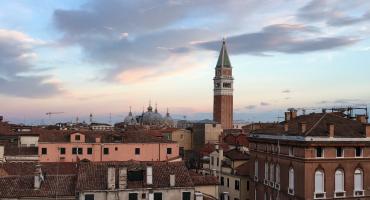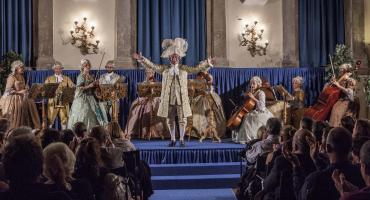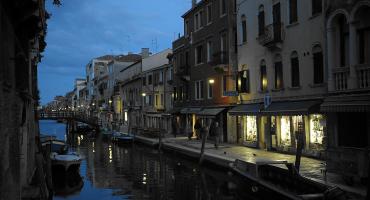It is the main opera theater in Venice, one of the most elegant in Italy. It was built during 1790-92 by the Noble Society of the Neoclassical architect Gianantonio Selva. Even if the lead times were actually reduced, there were many groups opposite to the realization of the new theatre, who drove their disapprovals to the position and to the increase of expenses compared to the 400.00 ducats expected. The inauguration was on May 16th, 1792 – during the Ascension day – with the play “I Giochi di Agrigento” by Giovanni Paisiello upon libretto of the count Alessandro Pepoli.
The theatre went under a traumatic destiny: it was burnt twice and twice it arose again from its ashes, just as the legendary bird.
On December 13th, 1836 it was almost consumed by flames, only a part of the entrance and the perimeter walls survived. It was immediately rebuilt according to the original form by the engineers Tommaso and Giovanni Battista Meduna.
During the 19th century the theatre hosted many opera performances and plays by great Italian author such as Gioachino Rossini (Tancredi, Sigismondo, Semiramide), Vincenzo Bellini (i Capuleti e i Montecchi, Beatrice di Tenda), Giuseppe Verdi (Ernani, Attila, Rigoletto, La Traviata, Simon Boccanegra).
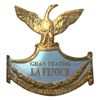 The premiere of La Traviata (March 6th, 1853), especially because the players were not up to the play and the thorniness of the theme, it was really a fiasco. It was then replayed the next year with better players and the play was two centuries backdated, it was then a success.
The premiere of La Traviata (March 6th, 1853), especially because the players were not up to the play and the thorniness of the theme, it was really a fiasco. It was then replayed the next year with better players and the play was two centuries backdated, it was then a success.
During the Venetian Republic under the Doge Marin, inside the theatre were held just concerts to collect funds for the Austrian opposition.
On January 29th, 1996 once again the theater was burnt out in flames, developed during some restoration works. The theatre was then rebuilt as it was before in about eight years.
During the works, all the performances of the Venetian Opera Company were held at the Palafenice, a temporary building especially created at Tronchetto, and at the Malibran Theatre.
On December 14th, 2003 the theatre was inaugurated, with the presence of the President of the Republic Carlo Azeglio Ciampi with a concert directed by Riccardo Muti, opening a one week celebration.
From January 1st, 2004 to celebrate the rebuilding of the famous theatre, the New Year’s Eve Concert is held, in conjunction with the Musikverein theatre in Wien. During the concert, particularly Italian but also foreign opera’s parts are played.
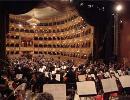 La Fenice’s façade is neoclassic with a showy staircase rising from the square to a high pronaos with four Corinthian columns with balustrade. The two statues on the recess, the Dance and the Music, are by Giovanni Battista Meduna, as well as the central decoration with the emblem of the legendary phoenix. The façade on the back, on the brook Santa Maria Zobenigo, was also built by Selva according to the Neoclassical style with a bossage covering the five arches of the ground floor and three big windows at the first floor.
La Fenice’s façade is neoclassic with a showy staircase rising from the square to a high pronaos with four Corinthian columns with balustrade. The two statues on the recess, the Dance and the Music, are by Giovanni Battista Meduna, as well as the central decoration with the emblem of the legendary phoenix. The façade on the back, on the brook Santa Maria Zobenigo, was also built by Selva according to the Neoclassical style with a bossage covering the five arches of the ground floor and three big windows at the first floor.
The interior, once richly decorated with stuccoes and gold plating decorations carried out in different ages, got all lost with the fire on 1996, but were all restored thanks to excellent craftsmen who perfectly copied the old decorations and furniture.
It is possible to visit the theatre upon booking, a very unique experience that will let you know the multiple backstage of its rooms and the players who treaded the boards.
Useful information:
Opening Hours for Visits:
- Open daily from 9:30 AM to 6:00 PM. (Please always check the official website for updated opening days and hours, as they may change: https://festfenice.com/orari)
Ticket Prices:
- Full ticket: €12.00
- Reduced ticket (seniors over 65): €9.00
- Student ticket (ages 7–26): €7.00
Reservations are neither required nor available. You can simply purchase your ticket at the theatre’s box office. Admission includes an audio guide, available in multiple languages.
Contacts:
La Fenice Theatre Switchboard: +39 041 786654
Email: info@teatrolafenice.org / visite@festfenice.com
For any further information, please check on website: https://www.teatrolafenice.it/
Address: Campo San Fantin, 1965, 30124 Venezia
How to get there: water-bus stop "S. Marco" or "Santa Maria del Giglio"

